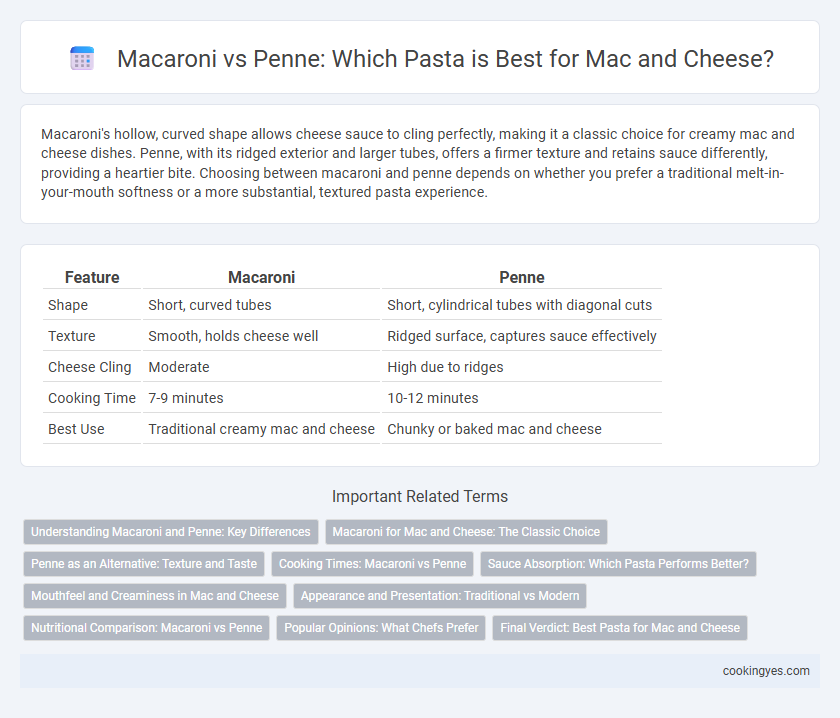Macaroni's hollow, curved shape allows cheese sauce to cling perfectly, making it a classic choice for creamy mac and cheese dishes. Penne, with its ridged exterior and larger tubes, offers a firmer texture and retains sauce differently, providing a heartier bite. Choosing between macaroni and penne depends on whether you prefer a traditional melt-in-your-mouth softness or a more substantial, textured pasta experience.
Table of Comparison
| Feature | Macaroni | Penne |
|---|---|---|
| Shape | Short, curved tubes | Short, cylindrical tubes with diagonal cuts |
| Texture | Smooth, holds cheese well | Ridged surface, captures sauce effectively |
| Cheese Cling | Moderate | High due to ridges |
| Cooking Time | 7-9 minutes | 10-12 minutes |
| Best Use | Traditional creamy mac and cheese | Chunky or baked mac and cheese |
Understanding Macaroni and Penne: Key Differences
Macaroni features a small, curved tubular shape ideal for capturing creamy cheese sauce in classic mac and cheese, while penne is larger with angled ends that create a denser bite and hold thicker sauces effectively. The hollow interiors and surface textures of both pastas influence sauce retention, with macaroni's smooth, narrow tubes offering a delicate chew compared to penne's ridged surface and sturdier structure. Selecting between macaroni and penne for mac and cheese depends on desired texture and sauce consistency, as macaroni yields a traditional creamy experience, whereas penne provides a heartier, more robust dish.
Macaroni for Mac and Cheese: The Classic Choice
Macaroni, especially elbow macaroni, remains the classic choice for mac and cheese due to its perfect size and shape that hold creamy cheese sauce effectively. Its hollow tube design traps the sauce inside, delivering a rich, velvety bite with every forkful. Compared to penne, macaroni offers a traditional texture and mouthfeel that has become synonymous with authentic mac and cheese recipes.
Penne as an Alternative: Texture and Taste
Penne offers a firmer texture and tubular shape that holds cheese sauce effectively, providing a satisfying bite compared to the softer, curved macaroni. Its ridged surface enhances sauce retention, making each mouthful flavorful and creamy. Choosing penne as an alternative for mac and cheese introduces a slight nutty taste and denser texture, delivering a unique twist on the classic comfort food.
Cooking Times: Macaroni vs Penne
Macaroni typically cooks faster than penne, with a boiling time of about 7 to 9 minutes compared to penne's 10 to 12 minutes. This shorter cooking time allows macaroni to achieve a tender yet slightly firm texture ideal for traditional mac and cheese recipes. Penne's denser shape and thicker walls require more boiling time to reach the same level of tenderness, influencing its creaminess when used in macaroni and cheese dishes.
Sauce Absorption: Which Pasta Performs Better?
Macaroni's curved, hollow shape allows for excellent sauce absorption, making it a classic choice for mac and cheese. Penne's cylindrical tubes with ridges also trap sauce effectively but offer a slightly firmer texture that holds up well in baked dishes. For creamy mac and cheese, macaroni typically performs better due to its compact size and ability to evenly coat each bite with sauce.
Mouthfeel and Creaminess in Mac and Cheese
Macaroni's curved tubular shape and smaller diameter create a tender, smooth mouthfeel that perfectly holds creamy cheese sauce, enhancing the overall richness in mac and cheese. Penne, with its larger size and ridged surface, offers a firmer bite and traps cheese in its grooves, contributing to a textured, slightly chunkier creaminess. For a classic mac and cheese experience prioritizing silky creaminess, macaroni consistently delivers a more cohesive and velvety sauce distribution.
Appearance and Presentation: Traditional vs Modern
Macaroni's curved, hollow tubes create a classic, nostalgic appearance perfect for traditional macaroni and cheese presentations. Penne's ridged, cylindrical shape offers a modern, textured look that holds sauces differently, giving the dish a contemporary twist in visual appeal. Choosing macaroni emphasizes comfort and familiarity, while penne introduces a sleek, stylish presentation ideal for modern culinary plating.
Nutritional Comparison: Macaroni vs Penne
Macaroni and penne both provide similar calorie counts, typically around 200 calories per cooked serving, but macaroni contains slightly more protein, averaging 7 grams per cup compared to penne's 6.7 grams. Macaroni offers a marginally lower glycemic index, which may influence blood sugar levels more favorably during digestion. Both pastas contribute comparable amounts of dietary fiber, iron, and B vitamins, making them nutritionally suitable choices for mac and cheese dishes.
Popular Opinions: What Chefs Prefer
Chefs often prefer macaroni for mac and cheese due to its small, hollow shape that captures creamy cheese sauce effectively. Penne is favored for dishes requiring a sturdier pasta that holds up to heavier, chunkier sauces, making it less common in traditional mac and cheese recipes. Popular opinion highlights macaroni's ability to balance texture and flavor, contributing to a classic comfort food experience.
Final Verdict: Best Pasta for Mac and Cheese
Macaroni remains the quintessential pasta for mac and cheese due to its tubular shape and hollow center, which captures creamy cheese sauce perfectly, ensuring every bite is flavorful. Penne, while similar in shape, features angled edges that can hold sauce but tends to have a firmer texture, making it less traditional for smooth, creamy dishes like classic mac and cheese. For the ultimate comfort food experience, macaroni's small size and curvature provide optimal sauce absorption and the iconic cheesy texture that defines classic mac and cheese.
Macaroni vs Penne for mac and cheese Infographic

 cookingyes.com
cookingyes.com